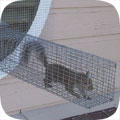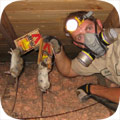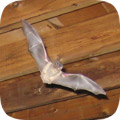- sussexcounty@wildlifeanimalcontrol.com
Call 24/7 for a free quote:
973-557-4775
Sussex County Wildlife Animal Control
Professional Wildlife Removal Company Servicing Sussex County, NJ
If you have a problem with wildlife in your Sussex County home, your best option is to hire a company that specializes in New Jersey wildlife removal only. This is a specialty business, and regular pest control companies do not use the proper techniques to solve animal problems. I have spent many years reviewing New Jersey and Sussex County, and I recommend the following:
EG Wildlife Removal
Cell Phone: 973-557-4775
NOTE: If you have a dog or cat problem, call the County Animal Services: 973-579-0370

EG Wildlife Removal specializes primarily in removing animals from attics of homes and buildings - this includes squirrels in attics, raccoons, and rats or mice in homes. New Jersey also has a documented problem with
bats in buildings, and EG Wildlife Removal is specially trained in bat removal. They also perform general wildlife trapping services, such as the capture and removal of skunks or opossums on the
property. Call 973-557-4775 to discuss your critter problem and schedule a same-day or next-day appointment. Click here to learn more about what prices we charge in 2023.
When hiring a company to solve your wild animal problem, you want these features:
- Specializes in wildlife removal, not pest control
- Fully New Jersey and the County licensed and insured
- Works 7 days per week (critters don't take weekends off)
- Performs full building inspections: enters and inspects attic
- Performs exclusion repairs, with guarantee against animal re-entry
- Offers cleanup of biohazardous wildlife waste
EG Wildlife Removal is a full-service Sussex County wildlife removal company. This is very different from a regular Sussex County pest control company. The pest control companies spray poison to kill insects. This is not at all
similar to wildlife removal. EG Wildlife Removal performs a full inspection of the home or property, and determines why the animal(s) are there, and if inside a building, how the animals got inside. All
animals (including rodents) are trapped and removed, or if possible, removed from the building using special exclusion devices. Once the animals are gone, preventative repairs are essential, and
cleanup is sometimes recommended.
 Sussex County wildlife trapping - it's not as simple as it may seem. It's illegal in New Jersey to trap without a license. Trap type is very important and there are many different types, bait is somewhat relevant, trap placement
is vital, and there are dozens of small things that are very important to know.
Safety is a concern. Then once the animal is trapped, it must be removed and dealt with in the proper manner according to New Jersey law. We offer Sussex County raccoon removal. Read more about how to get rid of raccoons.
Sussex County wildlife trapping - it's not as simple as it may seem. It's illegal in New Jersey to trap without a license. Trap type is very important and there are many different types, bait is somewhat relevant, trap placement
is vital, and there are dozens of small things that are very important to know.
Safety is a concern. Then once the animal is trapped, it must be removed and dealt with in the proper manner according to New Jersey law. We offer Sussex County raccoon removal. Read more about how to get rid of raccoons.
 Animals in attics - this is our specialty at EG Wildlife Removal. Many types of animals like to live in attics. This includes squirrels, raccoons, rats, mice, bats, birds, and even possums. Critters like to go into attics for a safe place to live
and raise their young. Removing animals from attics is very complex work, partly because of the presence of baby animals. If you need Sussex County squirrel removal, we can remove all the squirrels from your attic, and seal out any future ones. Read more about how to get rid of squirrels.
Animals in attics - this is our specialty at EG Wildlife Removal. Many types of animals like to live in attics. This includes squirrels, raccoons, rats, mice, bats, birds, and even possums. Critters like to go into attics for a safe place to live
and raise their young. Removing animals from attics is very complex work, partly because of the presence of baby animals. If you need Sussex County squirrel removal, we can remove all the squirrels from your attic, and seal out any future ones. Read more about how to get rid of squirrels.
 Rodent control must be done in a very specific way. First off, the most important thing is that all the openings that rats and mice can use to enter a house be sealed. Then all the rodents must be physically trapped and removed.
Never, ever use poison! Most Sussex County exterminators will just use this lazy poison technique to kill rodents, and it causes more harm than good - dead stinky rats, and it doesn't solve the problem. Call us for correct Sussex County rat removal. Read more about how to get rid of rats.
Rodent control must be done in a very specific way. First off, the most important thing is that all the openings that rats and mice can use to enter a house be sealed. Then all the rodents must be physically trapped and removed.
Never, ever use poison! Most Sussex County exterminators will just use this lazy poison technique to kill rodents, and it causes more harm than good - dead stinky rats, and it doesn't solve the problem. Call us for correct Sussex County rat removal. Read more about how to get rid of rats.
 Bat removal is a highly specialized task. New Jersey is known to have colonizing bats who often live in buildings. Bats love attics. If not removed, the colony can grow to a very large size over the years. The bat droppings are often corrosive and
cause health risks. The same goes for bird droppings on or in buildings. We perform Sussex County pigeon removal and bird control. But our specialty is Sussex County bat removal. We remove 100% of the bat colony and seal the building so that it's totally bat-proof. Read more about how to get rid of bats.
Bat removal is a highly specialized task. New Jersey is known to have colonizing bats who often live in buildings. Bats love attics. If not removed, the colony can grow to a very large size over the years. The bat droppings are often corrosive and
cause health risks. The same goes for bird droppings on or in buildings. We perform Sussex County pigeon removal and bird control. But our specialty is Sussex County bat removal. We remove 100% of the bat colony and seal the building so that it's totally bat-proof. Read more about how to get rid of bats.
 If you have animals inside a house, no job is complete without proper exclusion repairs. If you simply hire a Sussex County trapper who only removes the critters, then the problem will return. You need to hire a Sussex County wildlife control company that identifies 100% of the animal entry points
into your building, and seals them shut with professional repairs. In addition, in many cases animals have left waste or contamination behind, and you'll want a company that can provide professional cleaning services. EG Wildlife Removal does both.
If you have animals inside a house, no job is complete without proper exclusion repairs. If you simply hire a Sussex County trapper who only removes the critters, then the problem will return. You need to hire a Sussex County wildlife control company that identifies 100% of the animal entry points
into your building, and seals them shut with professional repairs. In addition, in many cases animals have left waste or contamination behind, and you'll want a company that can provide professional cleaning services. EG Wildlife Removal does both.
The above are just some of the services offered by EG Wildlife Removal. We also trap and remove animals that destroy lawns, such as moles, or digging animals. Sometimes animals like opossums will live under buildings, steal pet food, raid garbage cans, etc.
Read about how to get rid of opossums. Skunks commonly live under sheds or decks, and set up a den. We can trap and remove them without them spraying. Read about how to get rid of skunks. EG Wildlife Removal
also provides dead animal removal in Sussex County. If you need help with any other wildlife conflict, from a fox, beaver, groundhog, or any other critter, we can solve it. We also do Sussex County snake removal - most of the snakes in New Jersey are not venomous, but
call us if you want safe removal, or read about how to get rid of snakes in Sussex County. And remember, we are a private business, not the County Animal Control Services, so if you have a dog or cat problem, call the County at 973-579-0370.
the County animal services does not handle any wildlife issues.
EG Wildlife Removal: 973-557-4775
Sussex County Pricing Info For Year 2023
 Every wildlife removal situation is different, from the species of animals involved, the location of the animal inside a house or outside, the extent of repairs or cleanup, etc. It's impossible to give one-size-fits-all prices. Examples MIGHT include:
Every wildlife removal situation is different, from the species of animals involved, the location of the animal inside a house or outside, the extent of repairs or cleanup, etc. It's impossible to give one-size-fits-all prices. Examples MIGHT include:
Small Job: For example, a one-stop job to remove an animal in the yard: $100 on up
Medium Job: For example, getting critters out of your house with minor repairs: $300 on up
Large Job: For example, a project involving many service trips and complex work: $500 on up
Give us a phone call now and tell us about your wildlife issue and we will be able to give you a price estimate over the phone. If you're cool with it, we can schedule a same-day or next-day appointment if you like. Our prices are fair, and a good value because we do the job right, the first time.
Sussex County Wildlife Tip #1:
How to remove a dead rodent in the attic - Let me set the scene: you are sat in your house enjoying the Sunday morning papers, or doing laundry, or sitting in the tub and all of a sudden, you smell something that really does not smell great! What on earth was that? The smell dissipates and you go about your normal day, putting it down to something outside. The next day, you smell the same smell, but this time, it lasts for longer! What is that?! After a couple more days, the smell gets worse and worse, and it is very clear - that smell is coming from somewhere in your house! Ladies and gentleman, this could be a dead rodent living in your attic. Of course, the first step is to have a good sniff around to try and figure out where that stench is coming from - the attics and the basement are the first places that you should check out. You will often find that the insulation and other things in this area of the home means that it doesn't smell quite so bad, even though the animal has actually died there. You will have to take a few steps to sniff out the creature, and this could take a bit of practice. This is why many people tend to hire a wildlife expert - they will be much more knowledgeable. You will often find that the creature will have died in the insulation or under boards, so you should expect to do a bit of digging! Wearing gloves have a good pry around until you have found the carcass of the animal. This is not going to be a pretty side, and you will need a strong, sealable bag, or a large garbage bag that you can tie up at least. Chuck the carcass in the bag; holding your breath is going to be a good idea! If it has contaminated any of the boards or insulation around it, you are going to want to bag that up as well - otherwise you are essentially leaving the stench there. You should choose to get rid of your dead rodent in a way that is legal and final, and some people find that incinerating the creature is often the best idea to avoid attracting other rodents or problems.
Sussex County Wildlife Tip #2:
What sound do baby opossums make? -When you have an opossum in your home, there4 is always the worry that baby opossums will have accompanied it, especially if you find the animal during breeding season, which unluckily for you, is a fairly long one that ranges from December right through until October of the next year! Lucki8ly for you, you are probably going to hear these animals before you see them which will point you in the right direction as to where they are hiding, and there are a couple of distinct noises that you should be on the lookout for: The first noise you are likely to hear is a sneezing noise, or one that sounds like a small animal going "che". This is usual a talkative opossum calling to its mother for food or attention, or even just talking to its siblings. After a while, if the rest of the house is in silencer, you are probably going to hear this from the depths of the attic or your walls! The second noise is one that you are probably going to want to back away from, and this is the hissing noise. This is usually a call made by a baby opossum when it feels threatened or scared, and the last thing that you are going to want to do is wake up an angry mother that is just looking out for her young! When you hear this noise, you are in trouble and this is a good sign that the local wildlife people should be called in to resolve the problem!
New Jersey Wildlife Information:
New Jersey State bird: Eastern goldfinch
State mammal: Horse
tate fish: Brook trout
State insect: European honeybee
In the lovely state of New Jersey you'll find mountains, hardwood forests, pine forests, saltwater beaches and freshwater swamps. There are fields and plots of barren dust. New Jersey is one of the most bio-diverse places in the country. This variety means a fantastic selection of habitats for mammals, reptiles, amphibians, and birds. Over 1000 animal species live in New Jersey, not including humans.
The northwestern part of the state fits into the standard Northeast stereotype. It has hardwood forests and mountains much like Pennsylvania and New York. The northern part of the state is densely populated with people, and many of them make the commute to New York City for work. In this area, because of the habitat, black bears are frequent problem animals, raiding garbage cans at night. Some bears are daily visitors to neighborhood dumpsters and end up as a tourist attraction to distant observers. Coyotes are also found in this part of the state, but the wild canines are not as problematic as are bears in New Jersey.
The southern part of the state has a region known as the Pine Barrens. This landscape is full of thick pine forests and is sparsely populated by people. The Barrens have the usual host of skunks, raccoons, woodchucks, squirrels, and chipmunks, but they are also the home to the county's highest white-tailed deer population. The woods aren't just for the mammals. The Pine Barrens tree frog is a colorful amphibian that makes its home in the trees of New Jersey.
All those little creatures are great dinner ideas for the two largest snakes in the state, the black racer snake and the black rat snake. As you might expect, these large serpents look for rat-sized prey to make up their diets. Black racers and black rat snakes are not venomous. New Jersey only has two venomous snakes, the rattlesnake and the copperhead snake.
Birds are also numerous in the region. Bald eagles are slowly making a comeback, and the warmer weather is ideal for birds like robins, cardinals, sparrows, and geese. In fact, many migratory birds live in New Jersey but never have to migrate because of the mild temperatures. These birds tend to stay inland, leaving the coastal territories to seagulls and other crustacean-eating fowl.
You can always call EG Wildlife Removal, any time of day, at 973-557-4775, for a price quote for Sussex County wildlife control services. I am confident that this is the best choice amongst wildlife removal companies in Sussex County, NJ.





































